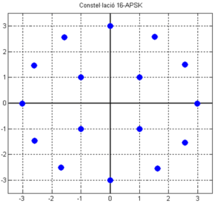Amplitude and phase-shift keying
Amplitude and phase-shift keying or asymmetric phase-shift keying (APSK) is a digital modulation scheme that conveys data by changing, or modulating, both the amplitude and the phase of a reference signal (the carrier wave). In other words, it combines both amplitude-shift keying (ASK) and phase-shift keying (PSK) to increase the symbol-set. It can be considered as a superclass of quadrature amplitude modulation (QAM). The advantage over conventional QAM, for example 16-QAM, is lower number of possible amplitude levels and lower PARP.[2]

| Passband modulation |
|---|
| Analog modulation |
| Digital modulation |
| Hierarchical modulation |
| Spread spectrum |
| See also |
|
Moreover, a careful design of the constellation geometry can approach the Gaussian capacity as the constellation size grows to infinity. For the regular QAM constellations, a gap of 1.56 dB is observed.[3] The previous solution, where the constellation has a Gaussian shape, is called constellation shaping.
References
- "Standard + Customized APSK Schemes For Satellite Transmission" By Donald Vanderweit, Agilent Technologies, Inc.
- Ershov, A.N., Berezkin, V.V., Petrov, S.V., Petrov, A.V. and Pochivalin, D.A., 2018. Features of Calculation and Design of High-Speed Radio Links for Earth Remote Sensing Spacecraft.
- H. Méric, Approaching The Gaussian Channel Capacity With APSK Constellations, IEEE Communications Letters.
Literature
- DVB-Flexible Serially Concatenated Convolutional Turbo Codes with Near-Shannon bound performance for telemetry applications, CCSDS-131.2-O-1.
- Xiang, Xingyu; Valenti, Matthew C (2012-10-17). "Closing the Gap to the Capacity of APSK: Constellation Shaping and Degree Distributions". arXiv:1210.4831 [cs.IT].
- De Gaudenzi, R., Guillén i Fàbregas, A. and Martinez, A., 2006. Turbo‐coded APSK modulations design for satellite broadband communications. International journal of satellite communications and networking, 24(4), pp.261-281.